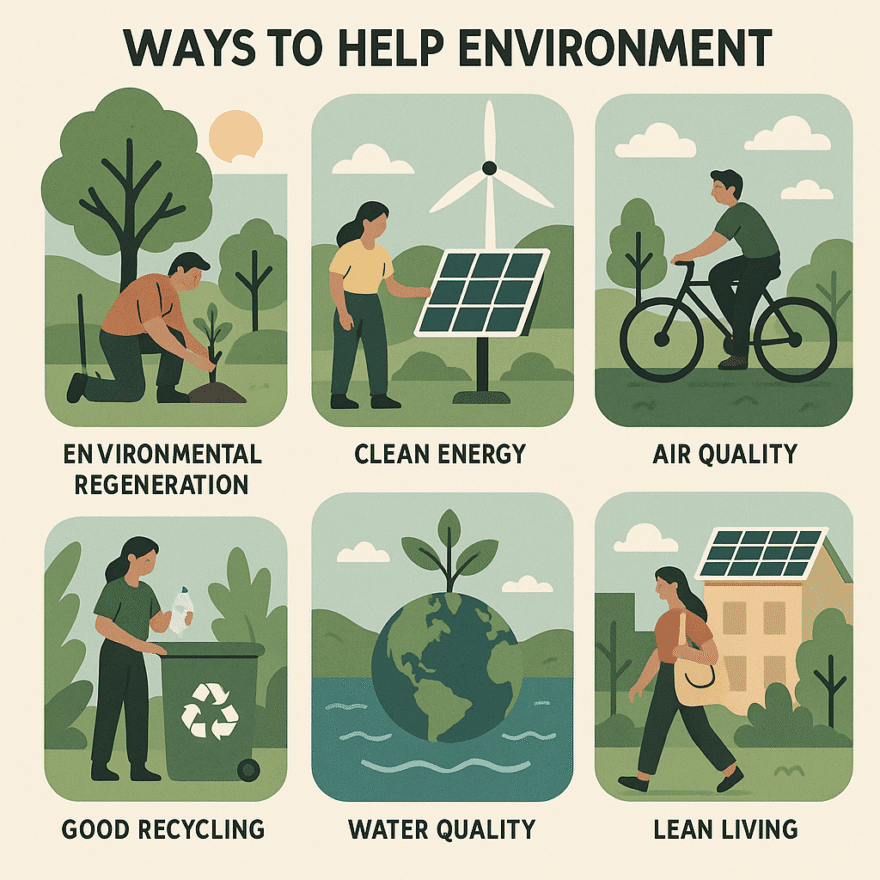Introduction
A sustainable environment is the foundation of all life. Clean air, fresh water, healthy soil, and stable climates are essential not just for ecosystems but for human health and wellbeing.
A sustainable environment means making choices that restore natural systems, reduce pollution, and conserve resources — ensuring that future generations inherit a thriving planet. This pillar explores practical ways individuals and communities can contribute to positive environmental change.
Key Takeaways
- Environmental regeneration restores damaged ecosystems.
- Climate action is essential for long-term planetary stability.
- Recycling, clean energy, and pollution reduction protect health and biodiversity.
- Lean living reduces waste and promotes a sustainable environment and efficient use of resources.
Environmental Regeneration
Environmental regeneration focuses on restoring degraded ecosystems so they can function naturally again. This can include reforestation, wetland restoration, and soil rebuilding, which improve biodiversity, strengthen climate resilience, and reverse environmental damage. By actively repairing natural systems, we can safeguard habitats and ensure a more stable environment for future generations.
Read more about Environmental Regeneration →
Climate Change and Sustainable Environment
Climate change is driven largely by greenhouse gas emissions from fossil fuels, deforestation, and industrial agriculture. Its effects — extreme weather, rising seas, and ecosystem disruption — threaten human health and economic stability. Tackling climate change means reducing emissions, increasing renewable energy adoption, and protecting carbon-storing ecosystems like forests and wetlands.
Read more about Climate Change →
Good Recycling
Recycling turns used materials into new products, reducing the need for raw resource extraction and landfill space. However, effective recycling depends on correct sorting and avoiding contamination — “wish-cycling” can cause entire loads to be discarded. Understanding your local recycling rules and reducing waste at the source are key to making the system work.
Read more about Good Recycling →
Clean Energy for a Sustainable Environment
Clean energy sources like solar, wind, and hydropower generate electricity without the carbon emissions of coal and gas. Switching to renewables not only cuts greenhouse gases but also reduces air pollution and reliance on finite fossil fuels. Individuals can support the transition by choosing green energy plans, improving home efficiency, and advocating for clean energy policies.
Read more about Clean Energy →
Air Quality
Air quality affects everything from respiratory health to climate patterns. Poor air quality, caused by pollutants like particulate matter and nitrogen oxides, can lead to chronic illness and premature death. Reducing vehicle emissions, improving industrial controls, and supporting clean energy all contribute to cleaner air, a sustainable environment — and cleaner lungs.
Read more about Air Quality →
Water Quality
Clean, safe water is essential for drinking, agriculture, and healthy ecosystems. Pollution from agriculture, industry, and sewage threatens both human health and biodiversity. Protecting waterways means reducing chemical runoff, improving wastewater treatment, and conserving water to promote a sustainable environment to keep ecosystems in balance.
Read more about Water Quality →
Lean Living
Lean living is about reducing excess and living more efficiently, saving both resources and money. This can mean downsizing possessions, cutting energy use, and choosing products designed to last. By consuming less and focusing on quality over quantity, we can reduce waste, lighten our environmental footprint, and simplify our lives.
Read more about Lean Living →
FAQ
Q: Can individuals really influence environmental change?
A: Yes — personal actions influence collective demand and drive policy and corporate change.
Q: What’s the most effective single step for sustainability?
A: It depends on your lifestyle — energy use, waste reduction, and diet shifts all have big impacts.
Q: Does sustainability cost more?
A: Not necessarily — many sustainable environment practices save money over time.





